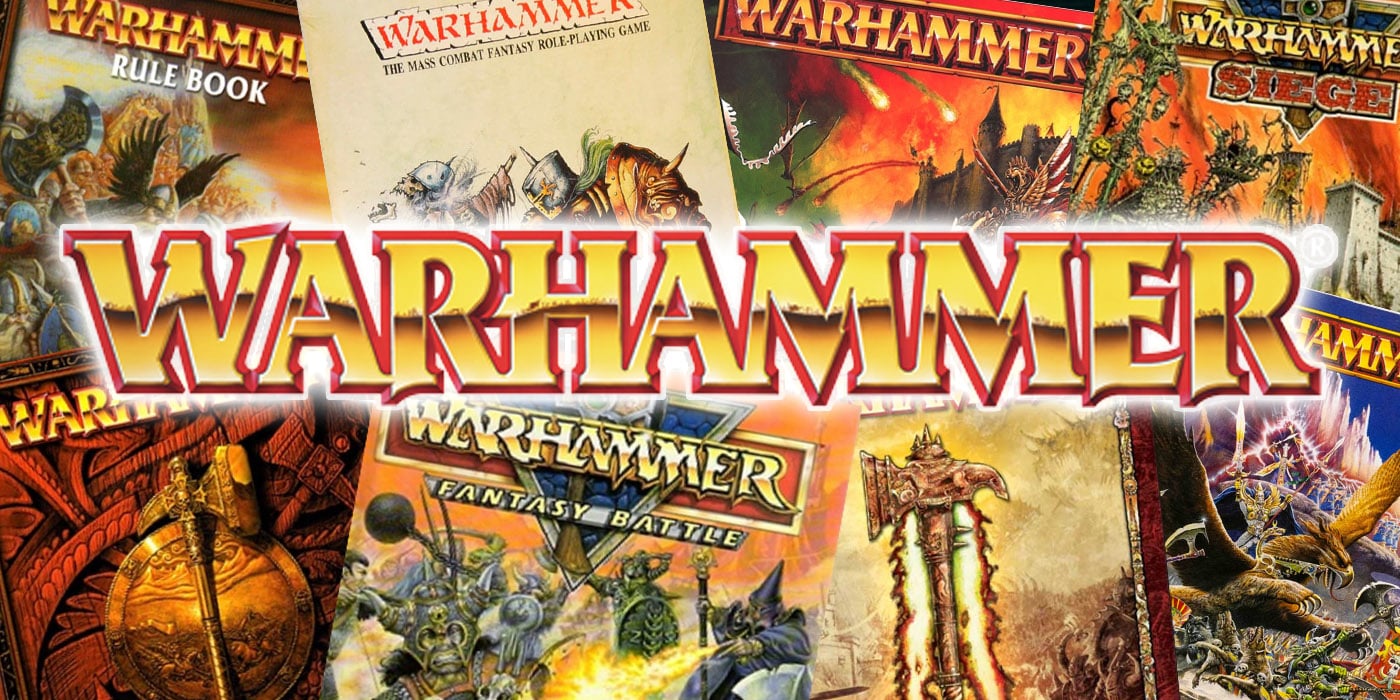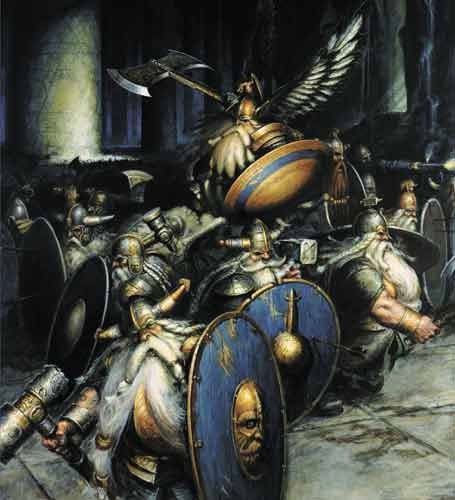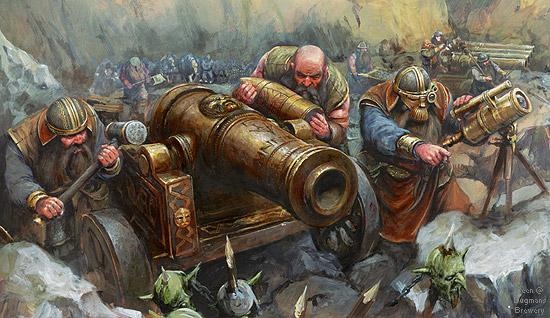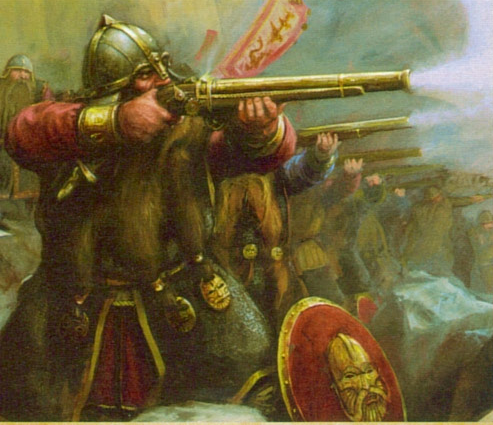WHFB Tactics: Dwarfs – Core

They’re short, they’re bearded, they’re grumpy – today we “delve deep” into the Dwarf Core units!
Hello there everyone, my name is Learn2Eel and welcome to my newest set of Unit Overview articles focused on the “stunties” – the mighty Dwarfs from the Warhammer Fantasy setting. While much of the background Games Workshop employs is heavily inspired by sources such as Tolkien, their own version of Dwarfs has proven most successful by carving out their own identity and distinct traits. Whether you are a beginner or a veteran when it comes to all things small and bearded, I hope you find this a useful series and hope you enjoy it!
Dwarf Warriors – While many may point to the superior stats of Longbeards and additional, handy special rules as good reason to use them to form your combat-based Core instead, Dwarf Warriors are nonetheless well priced models with their only real downside being that army-wide low Movement. For the exact same points cost as a Dark Elf Swordsman (or Bleaksword), a Dwarf Warrior with a shield trades Always Strikes First, Hatred of Elves and Murderous Prowess for a random form of Hatred against everything from Ancestral Grudge, the ability to march regardless of enemy proximity, a +1 Strength bonus on the charge and a +1 Parry bonus on the turn they are charged. As far as the stats are concerned, Dwarfs have two less Movement and three less Initiative – Dwarfs are slow, remember! – but they instead get Toughness 4 and Leadership 9 to compensate.
Additionally, Dwarf Warriors get heavy armour instead of light armour for a total 4+ armour save and 6+ parry save as opposed to an Elf’s 5+ armour and 6+ parry save. While the Bleakswords are undoubtedly better overall fighters and much more mobile, if you want an “anvil” unit that relies on Steadfast or high survivability to tie enemy units down then the advantages Dwarf Warriors bring are just far too significant to ignore. The point of these types of units is to be a “tarpit” or something that can hold up nasty enemies for a time – particularly heavy cavalry – due to their many ranks, not to try and kill stuff with their pitiful Strength 3 attacks. Elves have their re-rolls but ultimately Strength 3 with only re-rolls of 1s to wound just isn’t that great and makes for a poor fighting unit, something that sees most competitive Elf armies avoiding their Core melee infantry choices.
Dwarfs, on the other hand, get all that they could ever want in this particular choice because they are cheap 4+ armoured Toughness 4 models with great Leadership 9. Of course, if you play in an army list that doesn’t really require this type of unit or gets that kind of mileage out of Ironbreakers, then you could always give Dwarf Warriors great weapons for some of the cheapest Greatsword equivalents around. Given their poor Initiative 2 and good base 5+ armour save, this actually isn’t a terrible idea when you consider that they also strike at Strength 6 on the charge due to the Resolute special rule. Frankly, having even basic Core units armed with great weapons allows you to ignore the dreaded “Core tax” other armies suffer from where there Core units tend to be only useful as “tarpits”. Dwarf Warriors can be used in that role but having an entire unit dishing out Strength 5 attacks while still having 5+ armour and Toughness 4 is pretty darn good for a decade worth of points per model. Of course, there is somewhat of an elephant in the room that does leave Dwarf Warriors as somewhat more of a niche choice competitively.
Why take Dwarf Warriors when both Quarrelers and Thunderers are sitting right there beside them, sporting the exact same profile, armour save and (for the most part) upgrades but coming stock with powerful ranged weapons? They are a few points more per model which does add up the more you take in a unit, but seeing as the unit provides a ranged presence you can comfortably take a mere twenty models for shooting purposes and then reform into a five-wide and four-deep formation when combat is about to be joined. On the other hand, Dwarf Warriors need to be taken in units of at least twenty five to have any real value as a combat unit due to the Steadfast rules and their good but not great defensive stats. This means the overall points costs of each unit ends up being similar, while the Quarrelers and Thunderers fight just as well but can actually kill several models with shooting. In that sense, Dwarf Warriors are good on their own merits and certainly far better for tying enemy units up with tough Steadfast ranks than Empire Swordsmen or Dark Elf Bleakswords at similar points costs, but just don’t compare well to the other Core choices in the slot. Still, I would be lying if I said having an entire Core unit with great weapons was inherently bad, and despite their low Movement Dwarf Warriors are nonetheless very good value.
Competitive? Yes.
Quarrelers – If there is something about Dwarf infantry that makes them so deceptively alluring with their low points costs compared to their competitors from other armies for the same role, it is that darned awful army-wide Movement 3. Being the slowest force in the game can in no way be construed as a good thing given how important mobility is to a wide range of tournament builds lately, and it significantly reduces the value of all the dedicated melee units in the army book. Having all the damage output and survivability in the world won’t matter if the unit will never reach combat, something that (before the End Times) Tomb Kings players all know too well. This is a key issue with Dwarfs and not something that can be solved without investment in equipment such as the Strollaz Runic Banner or Bugman with a unit of upgraded Rangers, and also severely limits mostly combat-based armies. Not only is this one of the many reasons that Dwarf gun-lines are preferred for most competitive environments, but also why the “ranged” Core options tend to outshine both Dwarf Warriors and Longbeards for overall effectiveness. That Quarrelers and Thunderers share the exact same stats and equipment as Dwarf Warriors plus a shooting weapon unfortunately creates a “why would you use them” situation in regards to the latter unit.
As to which of the two ranged units is better, let us look at the primary difference – the Dwarf Crossbow and the Dwarf Handgun. The former has a 30″ range and is Strength 4, while the latter has a 24″ and is Strength 4 and Armour Piercing; both share the irritating Move or Fire special rule. Generally speaking the Dwarf Crossbow is better for the extra 6″ of total range and 3″ for firing at short range versus the Armour Piercing as you will be able to shoot for more turns and not suffer the long range penalties for as many shooting phases. Actually getting hits is generally better than getting fewer Armour Piercing hits, especially as Quarrelers can actually fire on the first player turn even if the opponent has no Vanguards or Scouts to deploy. What further separates the two units is that – for whatever reason – Quarrelers can take either shields or great weapons, but Thunderers are restricted to shields. Firing with Strength 4 Crossbows for several turns and then charging a nearby enemy unit with great weapons, or even just performing a Stand and Shoot first, leads to some incredibly damage potential from a basic Core unit. The regiment brings versatility unlike any of the other Dwarf Core choices with strong shooting and melee capabilities while retaining the signature survivability of all Dwarfs. They are are a great unit that is also probably the best in the Core slot for Dwarfs, though I would refrain from labeling an “obvious” choice as there are many situations or types of army lists that would be far better off with the other Core choices.
Competitive? Yes.
Thunderers – Given that I have already covered the basic profile shared between Warriors, Quarrelers and Thunderers as well as the differences between the two ranged units, I’ll try not to waste too much time repeating myself with this particular regiment. Thunderers are what you use if you don’t employ Organ Guns and want a unit that can put some serious damage on heavy cavalry outside of combat – a domain that Hammerers dominate with their multiple Strength 7 or Strength 6 great weapon attacks. The Armour Piercing bonus generally isn’t all that great as you still need to wound of course, though it is nonetheless a good buff and funny if only because it completely removes the 5+ armour saves typical of many Elven elites. Though I don’t really understand why it is the case, Thunderers are unfortunately explicitly prevented from taking great weapons despite their kit siblings in Quarrelers being able to. This limits their usage as a combat unit and thus makes them much less of a generalist semi-elite Core choice, though they are still good in the sense that Armour Piercing can sometimes be a more useful trade-off than an extra 6″ range. If you play against Warriors of Chaos, Empire or even Dark Elves, removing that extra point of armour can make all the difference in the world. Even if you just want a ranged unit, Thunderers still do well because they provide heavy shooting as opposed to the light chaff removal that most Archer types are restricted to.
Competitive? Yes.
Longbeards – I’m sure many Dwarf players are incredibly pleased that Longbeards are now a straight Core choice with no strings attached, though from a neutral perspective (mine) I believe it is good for varying up the many army lists the book can put out. Having an elite melee unit in line with Chaos Warriors for an army such as Dwarfs not only makes sense but allows for some awesome themed builds with low model counts, something that doesn’t work too well for many other armies. While one does have to remember that Longbeards are still Movement 3 like all other Dwarf Infantry and thus will have a hard time both reaching combat and choosing them, there is nonetheless a strong melee unit in plain sight here. Weapon Skill 5 and Strength 4 on top of the usual Dwarf Warrior profile is fantastic, just as Immune to Psychology makes them immune to all forms of Terror, Panic and Fear. That they act as a “unit battle standard bearer” by allowing friendly units within 6″ to re-roll failed Panic tests is incredibly useful, especially for melee-centric Dwarf builds that absolutely can’t afford to have any units flee given their low Movement values. This is a unit that, when equipped with great weapons, can provide a single Strength 7 attack per model on the charge due to the Resolute rule which makes for one heck of a nasty unit.
I do have a few issues with Longbeards though and that is role overlap with Hammerers and a certain inefficiency compared to Dwarf Warriors. The former is because Longbeards with great weapons are as expensive as Hammerers but are both inferior fighters and trade their useful but situational special rules for an amazing permanent Stubborn bonus. The latter, on the other hand, is because Longbeards are no more survivable than Dwarf Warriors when equipped identically despite having a not insignificant price gap per model. This leads to a bit of a tough spot for Longbeards as they don’t compete at all well with Hammerers for offense and compare poorly to their “lesser” Dwarf Warriors as an anvil. Still, one does have to remember that Immune to Psychology and the Old Grumblers special rules are decent, and being a Core choice does invite somewhat of a “tax” – the way Warhammer Fantasy army lists are designed leads to Special and Rare choices being more efficient than Core equivalents, but the fact that Core points are required is what causes this disparity. As Core units can be taken in unlimited amounts with no slot restrictions, it wouldn’t be right for Core choices to be better overall units than those in other slots. With that in mind, Longbeards with great weapons are well priced units when considering that they are Core options and thus form a good, solid fighting centre to build your army around. If you just want Longbeards with shields though, take Dwarf Warriors instead and save yourself a lot of points that can be put to good use elsewhere.
Competitive? Yes.
Summary!
Unlike some other slots in the Dwarf army book, all units in the Core slot are good for their points when contrasted against similar competitors from other army books and even against each other. Warriors are the cheapest and toughest block per point but generally suffer when compared to the other Core choices, while Quarrelers are the best all-rounder unit with access to great weapons in addition to their Dwarf Crossbows. Thunderers are superior to Quarrelers against slow elite armies and Longbeards are the well priced Chaos Warrior equivalents that put other Core options to shame as a pure melee option. At the very least, each has a clear purpose and all four units perform that role respectably.
Thank you all for reading this article! The Dwarf army-book does tend to suffer somewhat from poor internal balance with some options being clearly superior to their competitors in the same slots, but generally the book is well written with lots of cool rules and options to make up for the Dwarfs lack of hitting power in a melee and terrible movement speed.
I hope you found this article useful to your efforts as a young beardling or as a veteran of the World’s Edge Mountains and all the horrors they have spat forth over the millennia, and I wish you all to have a lovely day! Thanks again! Eel out.




